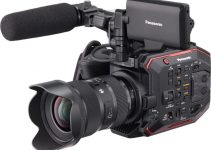There used to be much fewer options when we needed to choose a field monitor just a few years ago. A handful of brands dominated the market while hitting the shelves with steep prices, even though they provided extremely high quality in return. Now, a plethora of Chinese clones and low-quality plastic units have saturated the market making it even harder to find the right one.
Of course, there are a couple of viable options besides the most common ones coming from Atomos and Odyssey. Portkeys is a well-known brand, with more than a couple of interesting offerings, not only monitors but also other accessories and camera knick-knacks. In the video below, Mauro’s Film is comparing the Portkeys P6 5.5″ and Desview R5 5.5″, two very capable and quite cheap options, that are among the best ones you could pick right now. But which of the two rivals is exactly for you? Well, let’s figure out.
Let’s start this comparison by opening the boxes. The Portkeys offering comes with a hard-shell case, a clip-on sun-shade, an HDMI cable, and an L-bracket with the user manual. It also has thin bezels, 500 nits of brightness and 1000:1 contrast ratio, but lacks touchscreen capabilities.
Furthermore, the Portkeys P6 has an HDMI passthrough, and a 3.5mm jack on the left. There’s also a 1/4″ mount on the right, and another one on the bottom, where you’ll also find a USB port to load LUTs on the fly.
On the top of the unit, there are a few buttons to navigate through settings and menus alongside four function buttons and on and off switch. The whole thing is powered by NPF or EL-P6 batteries.
The Portkeys P6 is simple, has all of the most needed functions such as histograms, grids, false colors and transparency, various aspect ratios and everything in between. It’s a decent field monitor, nothing fancy, though. And that is not a problem if you’re looking for a basic device that won’t cost you an arm and a leg.
The Desview R5, on the other hand, costs $249, which is much more than the $169 needed to get the Portkeys rival. The former is bigger and heftier than the P6, and comes with a snail mount, unlike the P6 that has an L-bracket.
Both monitors have sunshades and HDMI cables, but the R5 comes with a nice plus. Inside the box, there’s a D-Tap adapter, so you can use it to power the camera and the monitor with the same V-Mount battery in case you opt for such a power unit.
Other than that, the contrast ratio of both displays is similar, even though the P6 is a little bit brighter (500 nits against 450) but not even close to a brightness that can be useful on the outside.
So, is it worth the price difference of almost $100? Well, first of all, the R5 has a touchscreen display which makes life on set much faster if not easier.
Plus, it has more essential view assist tools such as exposure assist, zebras, HDR compatibility, a DC output, just to name a few. These are small details that may justify the price difference for some users. Overall, the build quality and functionality of the Desview R5 belong to a higher tier.
Ultimately, if you’re looking for a simple reference monitor that you’ll predominantly use as a framing tool to substitute your tiny mirrorless’s screen, then the P6 seems like a no-brainer. If instead, you’re in the market for a more functional field monitor packed with all the bells and whistles, then the R5 might be a better fit for your workflow.
[source: Mauro’s Film]
Order Links:
Portkeys P6 Camera Field Monitor (B&H, Amazon)
Desview R5 On-Camera Touch Screen Monitor (Momanplay)
Disclaimer: As an Amazon Associate partner and participant in B&H and Adorama Affiliate programmes, we earn a small comission from each purchase made through the affiliate links listed above at no additional cost to you.



